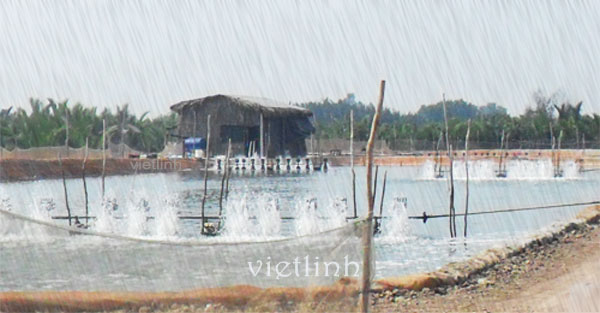6/ Methods of increasing alkalinity in ponds
• Alkalinity suitable for black tiger prawn is from 90 to 130ppm, for whiteleg shrimp is 100-150ppm.
• Mix dolomite lime in fresh water for 24h, and then splash it into ponds at 8-10 P.M. at night.
• Each 1,655g of dolomite lime increases alkalinity of 1m3 water into 1 mg/ml.
• How to calculate the amount of dolomite lime: to increase alkalinity of a 5000m3 pond from 80mg/ml to 90mg/ml:
The amount of dolomite lime used = 5,000 x 1,655 x (90-80) / 1000 = 82,75kg
• When increasing alkalinity of water in ponds, Viet Linh notices that only increase 1 time 10mg/ml then again, but not too much at 1 time because it will cause shocks in shrimp.
• If the method above does not increase or increases slowly alkalinity, we can use the following method:
• Combine 70% soda lime (NaHCO3) according to the above formula, 30% dolomite lime in fresh water for 24 hours; splash the mixture at 8-10 P.M. at night.
7/ Algae management when salinity is lower than 8 ppt
When salinity of the pond is lower than 8 ppt, blue-green algae often appears. Situations happen during that point:
• Algae are often blighted.
• pH changes significantly during the day
• Shrimps are covered with algae.
• The lack of oxygen in early morning often occurs.
• Shrimps with black gill disease and other gill diseases.
Solutions:
• Reduce feed.
• Use BKC 800 with 0,5ppm concentration. Apply it in 1/3 area of the pond, downwind without aerators.
• Take out algae foam that remains after applying treatments for ponds.
• Repeat 2 or 3 times these methods.
• Use probiotic with a combination of zeolite to absorb toxic gases caused by dead algae at the bottom of the pond.

8/ Managing turbidity in pond
In pond, turbid water is mainly caused by clay particles. Turbid water affects the following factors:
• Limit photosynthesis of algae in the pond; cause the lack of oxygen and high CO2 concentrations that increase shrimp suffocation.
• Algae are decimated suddenly
• Alluvium clinging in shrimp gills causes swelling or yellow gills.
Increase water changes in ponds and use probiotics.
9/ Managing toxic gases NH3, H2S, CH4
• Avoid excess feed.
• There is a need of treatment pond to change water frequently in the last months.
• Using probiotics regularly.
• Siphon the bottom of the pond to take out waste.
• Increase aeration systems.
• Stablize pH from 7.8 to 8.2
• Measure the concentration of NH3, H2S, NO2- (NO2- often appear in ponds with salinity <10 ppt).
10/ Feeding according to schedule and reducing feed intake when it rains or when the rain is coming
• As soon as it is cloudy and about to rain, the amount of feed should be reduced or even stopped if the rain approaches. Wait until the rain ceases and feed with 30-50 percent feed fewer than the normal amount.
• To ensure shrimp resistance and prevent soft-shelled shrimp, synthetic vitamins, minerals and vitamin C can be mixed in feed every day.
Viet Linh © 2016
 See "Manage shrimp ponds during rainy season - Part 1"
See "Manage shrimp ponds during rainy season - Part 1"